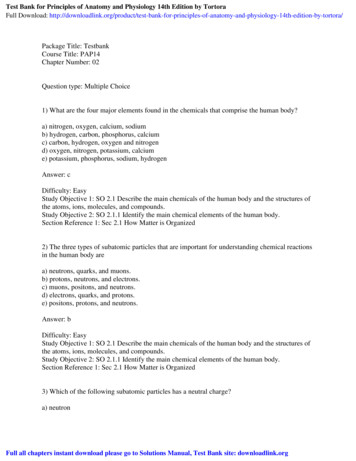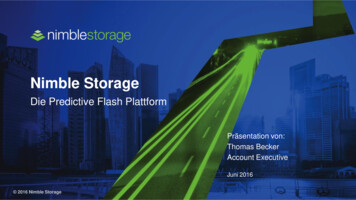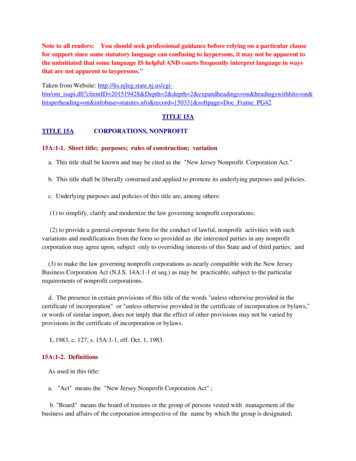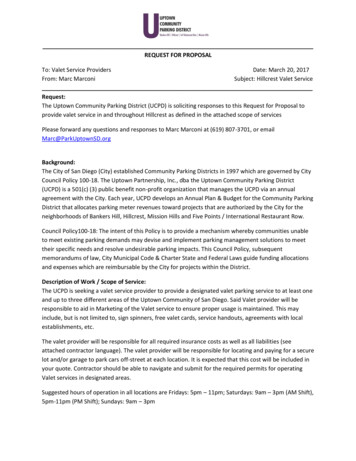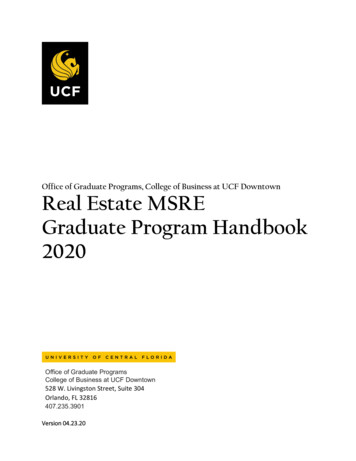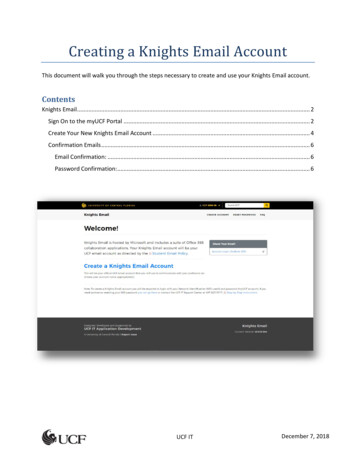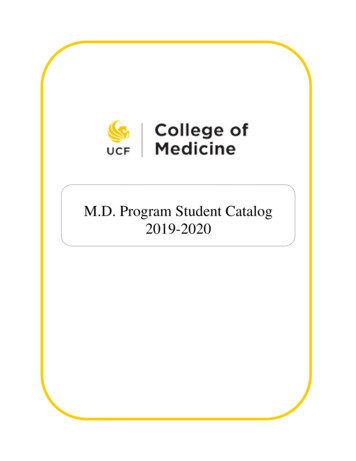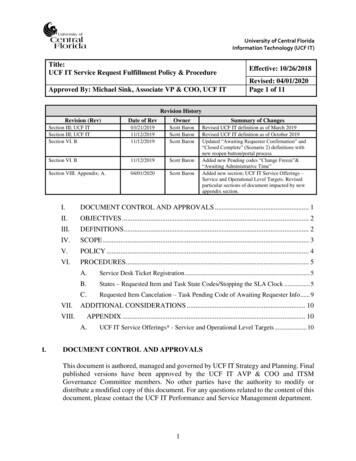
Transcription
University of Central FloridaInformation Technology (UCF IT)Title:UCF IT Service Request Fulfillment Policy & ProcedureApproved By: Michael Sink, Associate VP & COO, UCF ITEffective: 10/26/2018Revised: 04/01/2020Page 1 of 11Revision HistoryDate of RevOwnerSection III; UCF ITSection III; UCF ITSection VI. BRevision (Rev)03/21/201911/12/201911/12/2019Scott BaronScott BaronScott BaronSection VI. B11/12/2019Scott BaronSection VIII. Appendix; A.04/01/2020Scott BaronI.DOCUMENT CONTROL AND APPROVALS . 1II.OBJECTIVES . 2III.DEFINITIONS . 2IV.SCOPE . 3V.POLICY . 4VI.PROCEDURES. 5VII.VIII.A.Service Desk Ticket Registration . 5B.States – Requested Item and Task State Codes/Stopping the SLA Clock . 5C.Requested Item Cancelation – Task Pending Code of Awaiting Requester Info . 9ADDITIONAL CONSIDERATIONS . 10APPENDIX . 10A.I.Summary of ChangesRevised UCF IT definition as of March 2019Revised UCF IT definition as of October 2019Updated “Awaiting Requester Confirmation” and“Closed Complete” (Scenario 2) definitions withnew reopen button/portal processAdded new Pending codes “Change Freeze”&“Awaiting Administrative Time”Added new section; UCF IT Service Offerings –Service and Operational Level Targets. Revisedparticular sections of document impacted by newappendix section.UCF IT Service Offerings* - Service and Operational Level Targets . 10DOCUMENT CONTROL AND APPROVALSThis document is authored, managed and governed by UCF IT Strategy and Planning. Finalpublished versions have been approved by the UCF IT AVP & COO and ITSMGovernance Committee members. No other parties have the authority to modify ordistribute a modified copy of this document. For any questions related to the content of thisdocument, please contact the UCF IT Performance and Service Management department.1
II.OBJECTIVESThis document is intended to define and describe a consistent service request fulfillmentprocess that aims to improve UCF IT service quality. The service request fulfillmentprocess provides a channel for UCF IT consumers to request and receive active UCF ITservices. The process needed to fulfill a service request will vary depending upon what isbeing requested. The request fulfillment processes and procedures will enable IT staff tomonitor and fulfill service requests quickly, consistently and efficiently.The objectives of the UCF IT Service Request Fulfillment process are to: III.Provide a simple means for the university to receive standard services for which apre-defined approval and workflow process existsProvide customers with a single source of information regarding the UCF ITservices available and how to obtain themDEFINITIONSService Request: Request (defined as a Class Name “Requested Item” withinServiceNow) from a customer for creating, modifying, adding, moving, or removing someor all service functionality, access, or infrastructure components. Referred to as a “catalogitem” within ServiceNow.Service Catalog: The service catalog is part of the service portfolio and containsinformation about two types of IT service: customer-facing services that are visible to theuniversity; and supporting services required by the service provider to deliver customerfacing services.Service Level Agreement (SLA): An agreement between an IT service provider and acustomer. A service level agreement describes the IT service, documents service leveltargets (SLTs), and specifies the responsibilities of the IT service provider and thecustomer.Service Level Target (SLT): A commitment that is documented in a service levelagreement. Service level targets are based on service level requirements and are needed toensure that the IT service is able to meet business objectives. They should be SMART(Specific, Measurable, Attainable, Realistic and Time Bound) and are usually based onkey performance indicators (KPIs).Operational Level Agreement (OLA): An agreement between an IT service providerand another part of the same organization. It supports the IT service provider’s delivery ofIT services to customers and defines the good or services to be provided and theresponsibilities of both parties.2
New “Call”: A customer contact recorded by the UCF IT Service Desk. If the contact isan incident or service request, then the agent transfers the information by creating anotherrecord to the applicable incident or requested item table.Ad-hoc Task: A manual (stand-alone) task created on the service request that is not tiedto the predefined catalog task workflow. NOTE: Setting an ad-hoc task to one of thecancel request states will not affect the requested item state. Only catalog tasks driven offthe workflow can cancel a requested item.Catalog Task: A task generated by predefined workflow activity.Requested For: The field within ServiceNow that identifies the individual requestingassistance. This is the customer of the service request.Opened By: The field within ServiceNow that identifies the individual that actuallycreates (submits) the ticket.Work Notes: A field within ServiceNow used to document activities associated with theservice request. This field is internally facing to ServiceNow fulfillers.Activity Log: A field within ServiceNow that is systematically logged which captures allactivities of a ticket such as email notifications sent, work notes updates, additionalcomments added or changes to any fields.IT Service Management (ITSM) application: This is the application (ServiceNow) usedby UCF IT to record incidents, problems, service requests and changes.UCF IT (as of October 2019): College of Arts and Humanities, College of BusinessAdministration, College of Community Innovation and Education, College of HealthProfessions and Sciences, College of Sciences, Student Development and EnrollmentServices, Digital Learning, College of Undergraduate Studies, Office of InstructionalResources, UCF Connect, University Libraries, Human Resources, UCF Foundation,Student Health ServicesInformation Technology Infrastructure Library (ITIL): A set of best practicepublications for IT service management. Owned by the Cabinet Office (part of HMGovernment), ITIL gives guidance on the provision of quality IT services and theprocesses, functions and other capabilities needed to support them.IV.SCOPEThe process of handling each type of service request can be broken down into a set of welldefined activities and can be documented as a process flow (known as workflows). Theworkflows are all built and stored within the ServiceNow catalog item repository.3
When defining service request workflows, the service provider should consider thefollowing points: Who will handle the request? - Defines individuals or teams who areresponsible for the request fulfillment.How is the service delivered? - Defines the process of service delivery.How quickly will the service request be fulfilled? - Reflects the defined SLA ortime window (SLT). Reference Appendix A. for UCF IT Service and OperationalLevel Targets per each active UCF IT service offering.The UCF IT Service Request Fulfillment Process WILL cover: Service requests associated with active UCF IT services in the service catalogService Level Agreements/Targets and Operational Level Agreements/Targets Continuing to baseline average times to fulfillment across active UCF ITservice offerings. Service and Operational Level Targets can be modifiedand will be added and documented within Appendix A.The UCF IT Service Request Fulfillment Process WILL NOT cover (at this time): V.Non-UCF IT service offeringsSystematically prioritizing service requests (e.g. Incident Management VIP’s)Change requests addressed by the UCF IT Change Management processKnowledge requests addressed by the UCF IT Knowledge Management processPOLICYUCF IT staff members will record and document within the ITSM application(ServiceNow) ALL customer requests for assistance in regard to service requests. UCFIT staff members will follow the UCF IT Service Request Fulfillment procedures toreview, follow-up and fulfill these ticket types in a timely manner. The work notes shouldbe updated routinely (when applicable). All in-scope activity will follow the processdefined by this document.The UCF IT Support Center is the primary point of contact for all customers and will beavailable by multiple methods, including Web, Email or Telephone to facilitate incidentor service request submissions. Web – via self-service portal page: https://ucf.service-now.com/ucfitEmail – itsupport@ucf.eduTelephone – 407-823-5117Requests for service fulfillment will be recorded as requested items in the ITSMapplication (ServiceNow) and will be subject to measurement and reporting.4
VI.PROCEDURESA.Service Desk Ticket RegistrationThere are currently three ways for a customer to contact the UCF IT Support Centerand request assistance: Web (Self-Service Portal Page)A UCF IT Support Center agent creates and triages (if applicable) theweb request (either an incident or service request) from the “new call”queueORThe customer directly submits a service request through the servicecatalog, which is systematically triaged to the service owner Email – A UCF IT Support Center agent converts the email request (ifapplicable) into a ServiceNow ticket (either an incident or service request) Telephone – A UCF IT Support Center agent captures all required informationand creates (if applicable) a ServiceNow ticket (either an incident or servicerequest)The customer is sent an automated acknowledgement email when the ticket iscreated within ServiceNow.B.States – Requested Item and Task State Codes/Stopping the SLA ClockThere are six requested item state codes that are/may be reflected during the lifecycleof a service request (from create to fulfillment). The requested item state codes aredriven off the related workflow tasks and their represented/selected states.NOTE: The requested item states are read-only fields within ServiceNow.The state codes for both requested items and tasks are defined below and reflectwhen the “SLA” clock is running or stopped.NOTE: The current service and operational level targets determined by UCF ITservice providers are identified within Appendix A. The UCF IT serviceproviders have agreed to fulfill the active service offering(s) on an average basisagainst the targets identified. These targets are variable and are subject tochange. The targets identified in Appendix A. are business days and account fortotal time elapsed when the SLA clock is running.5
Requested Item States:StateOpenWork In ProgressPendingAwaiting Requester ConfirmationClosed CompleteCanceled StatusLogged (start the clock). Work to fulfillrequest has not begunA related task has begun/In progress(SLA clock running)ALL related opened tasks are pending(stops the clock)Final workflow task completed (stops theclock). Customer able to reopen withinthree business daysAuto-close/Process owner involvementUnable to reach customer, servicerequest no longer required perconfirmation from customer, removeduplicate ticket(s) or incorrect catalogitem that needs to be resubmitted orconverted to an incidentOpen - The requested item is created within ServiceNow and the approvalprocess has started (if applicable). Work to fulfill the request has not begun.o The SLA clock starts.Work In Progress – Work to fulfill the requested item has begun or is in progress.All approvals have been completed (outside of mid-workflow approvals) and atleast one related task has been set to a “Work In Progress” State.o The SLA clock IS running.Pending – The requested item is awaiting a pending action outside of UCF IT’scontrol, a change freeze is in effect or per University/UCF IT directive, normaloperations conclude earlier than normal business hours due to planned orunplanned events. The pending state will systematically set when one (if solerelated task) or ALL related tasks are in a pending state.o The SLA clock is paused and IS NOT running.Awaiting Requester Confirmation – Following the last task of the requested itemworkflow being completed, the requested item state will systematically set to“Awaiting Requester Confirmation”. The customer will have the option to reopentheir request through email or the self-service portal (a systematic email with aReopen Ticket! button is sent when the requested item state changes to“Awaiting Requester Confirmation” or a Reopen Ticket! button appears withinthe self-service portal when the requested item state changes to “AwaitingRequester Confirmation).o The SLA clock is paused and IS NOT running.NOTE: If an ad-hoc task has been created on the requested item and is notclosed before the last task of the requested item workflow, then the ad-hoc taskwill systematically close to prevent tasks from remaining opened after therequested item is deemed complete. This ServiceNow system action takes placebefore the requested item state changes to “Awaiting Requester Confirmation”.6
An ad-hoc task cannot be created after the state of the requested item changesto “Awaiting Requester Confirmation”. Closed Complete – The requested item has been fulfilled to customersatisfaction.o The closed complete state is systematically set following these two scenarios: Scenario 1: The requested item auto-closes in three business days. Scenario 2: The customer indicates their service request was notfulfilled to their satisfaction by choosing to reopen their requestthrough email or the self-service portal (a systematic email with aReopen Ticket! button is sent when the requested item state changesto “Awaiting Requester Confirmation” or a Reopen Ticket! buttonappears within the self-service portal when the requested item statechanges to “Awaiting Requester Confirmation).Following the customer confirmed reopen, the process owner of thecatalog item will be notified and assigned a task indicating thatcustomer action is required. The newly assigned task will set to anOpen state and the SLA clock will start again (requested item statewill set back to Work In Progress).Once the process owner ensures the request has been fulfilled tocustomer satisfaction, they will close complete the task, which willclose complete the requested item. Canceled – The requested item is no longer required. The assignee of one of theopened requested item related task(s) concludes the request is no longer requiredto be fulfilled (either unable to contact customer for more information, customerindicates they no longer require the service, cancel a duplicate ticket(s) or cancelan incorrect catalog item that needs to be resubmitted or converted to anincident).Task StatesThere are seven task state codes. Only six task state codes can be selected during thelifecycle of a service request. When a task is spawned from the requested item, thestate defaults to Open.StateOpen (defaults – cannot be selected)Work In ProgressPendingClosed CompleteClosed SkippedCancel Request - No Response7StatusWork to fulfill the task has not begunWork to fulfill the task has begunPending action outside of UCF ITcontrol, change freeze in effect orapplicable Admin Time(see Pending Code definitions below)Task fulfilled/completedTask no longer required or applicableService request no longer required due tonot being able to reach customer
Cancel Request - Customer Service request no longer required perconfirmation from customer, removeduplicate ticket(s) or incorrect catalogitem that needs to beresubmitted/converted to an incidentOpen - Work to fulfill the task has not begun. Once a task assignee moves a taskinto “Work In Progress”, the task state of Open will no longer be able to beselected.Work In Progress – Work to fulfill the task has begun.Pending – A task can ONLY be put into a pending state if one of the six pendingcodes below are applicable.NOTE: The task assignee will be required to complete a pending codeselection and reason on why the task is in a pending state.Pending Codes: Awaiting Requester Info – If the task assignee requires additionalinformation from the customer to proceed with the task. Once therequired information is received from the customer, the task should beplaced back into a “Work In Progress” state (if applicable) by the taskassignee.Awaiting Business Decision Outside of UCF IT Control – If adecision to move forward and complete the task is pending a businessdecision to be made that is outside of UCF IT’s control. Once thedecision is made, the task should be placed back into a “Work InProgress” state (if applicable) by the task assignee.Awaiting Vendor – If a task is dependent on third-party vendoraction. Once the vendor takes action, then the task should be placedback into a “Work In Progress” state (if applicable) by the taskassignee.Awaiting Requester Fulfillment Date – If the requested item has beencreated proactively and work cannot start on a task until a future dateapproaches. Once the future fulfillment date arrives, the task assigneeshould place the task into a “Work In Progress” state (if applicable).Awaiting Administrative Time – Per University or UCF IT directive,normal operations conclude earlier than normal business hours due toplanned or unplanned events (i.e. weekday home football game, UCFIT department wide events (picnics, sporting events), unplannedcampus closure, etc.) If the task assignee is impacted and is unable towork on the task, the task should be changed to a State of “AwaitingAdministrative Time” when the event time approaches. The followingbusiness day, the task assignee is responsible to put the task back inits previous State.8
Change Freeze – At certain critical times of the year (semester start),UCF IT imposes a change freeze period. During this time, it is thediscretion of each UCF IT department to authorize or prohibitcontinued work to fulfill a service request. The UCF IT department ispermitted to use the “Change Freeze” Pending Code during thechange freeze window. Following the change freeze window end, thetask should be placed back into a “Work in Progress” state (ifapplicable) by the task assignee.Closed Complete – Task fulfilled/completedClosed Skipped – Task no longer required or applicable. Next task of theworkflow will be spawned (if applicable) and the service request is still requiredto be fulfilledCancel Request - No Response – Service request no longer required. Unable toreach customer for additional information after three attempts (See Section C. forthis process). This selection will cancel the catalog item and the requested itemstate will change to Canceled.Cancel Request - Customer – Customer confirmed the service request is nolonger required.NOTE: This task state should also be used if the service request is beingcanceled due to being a duplicate ticket or if the request was incorrectlysubmitted using the wrong catalog item/request needs to be converted toan incident. The customer should be informed that their request will becanceled to ensure there is no confusion when the applicable cancelnotification is spawned. This selection will cancel the catalog item andthe requested item state will change to Canceled. The task assignee willbe requi
3 New “Call”: A customer contact recorded by the UCF IT Service Desk.If the contact is an incident or service request, then the agent transfers the information by creating another record to the applicable incident or requested item table.

